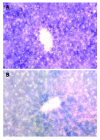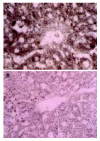Dynamical changing patterns of glycogen and enzyme histochemical activities in rat liver graft undergoing warm ischemia injury
- PMID: 15849830
- PMCID: PMC4305762
- DOI: 10.3748/wjg.v11.i17.2662
Dynamical changing patterns of glycogen and enzyme histochemical activities in rat liver graft undergoing warm ischemia injury
Abstract
Aim: To investigate the changing patterns of glycogen and enzyme histochemical activities in rat liver graft under a different warm ischemia time (WIT) and to predict the tolerant time limitation of the liver graft to warm ischemia injury.
Methods: The rats were randomized into five groups, WIT was 0, 15, 30, 45, 60 min, respectively, and histochemical staining of liver graft specimens was observed. The recovery changes of glycogen and enzyme histochemistry activities were measured respectively 6 and 24 h following liver graft implantation.
Results: The activities of succinic dehydrogenase, cytochrome oxidase, apyrase (Mg++-ATPase) and content of glycogen were decreased gradually after different WIT in a time-dependent manner. The changes were significant when WIT was over 30 min.
Conclusion: Hepatic injury is reversible within 30 min of warm ischemia injury. Glycogen and enzyme histochemistry activities of liver grafts and their recovery potency after reperfusion may serve as criteria to evaluate the quality of liver grafts.
Figures
References
-
- Busuttil RW, Tanaka K. The utility of marginal donors in liver transplantation. Liver Transpl. 2003;9:651–663. - PubMed
-
- Fondevila C, Busuttil RW, Kupiec-Weglinski JW. Hepatic ischemia/reperfusion injury--a fresh look. Exp Mol Pathol. 2003;74:86–93. - PubMed
-
- Hines IN, Harada H, Wolf R, Grisham MB. Superoxide and post-ischemic liver injury: potential therapeutic target for liver transplantation. Curr Med Chem. 2003;10:2661–2667. - PubMed
-
- Selzner N, Rudiger H, Graf R, Clavien PA. Protective strategies against ischemic injury of the liver. Gastroenterology. 2003;125:917–936. - PubMed
-
- He XS, Ma Y, Chen GH, Zhang JX, Wu JL, Liang YJ, Lin GY, Zhu ZY, Hu RD, Huang JF. The influence of warm ischemia injury on viability and posttransplantative outcome of liver graft from non-heart-beating donor in rats. Zhonghua YiXue ZaZhi. 2003;83:1236–1240. - PubMed
Publication types
MeSH terms
Substances
LinkOut - more resources
Full Text Sources
Medical





